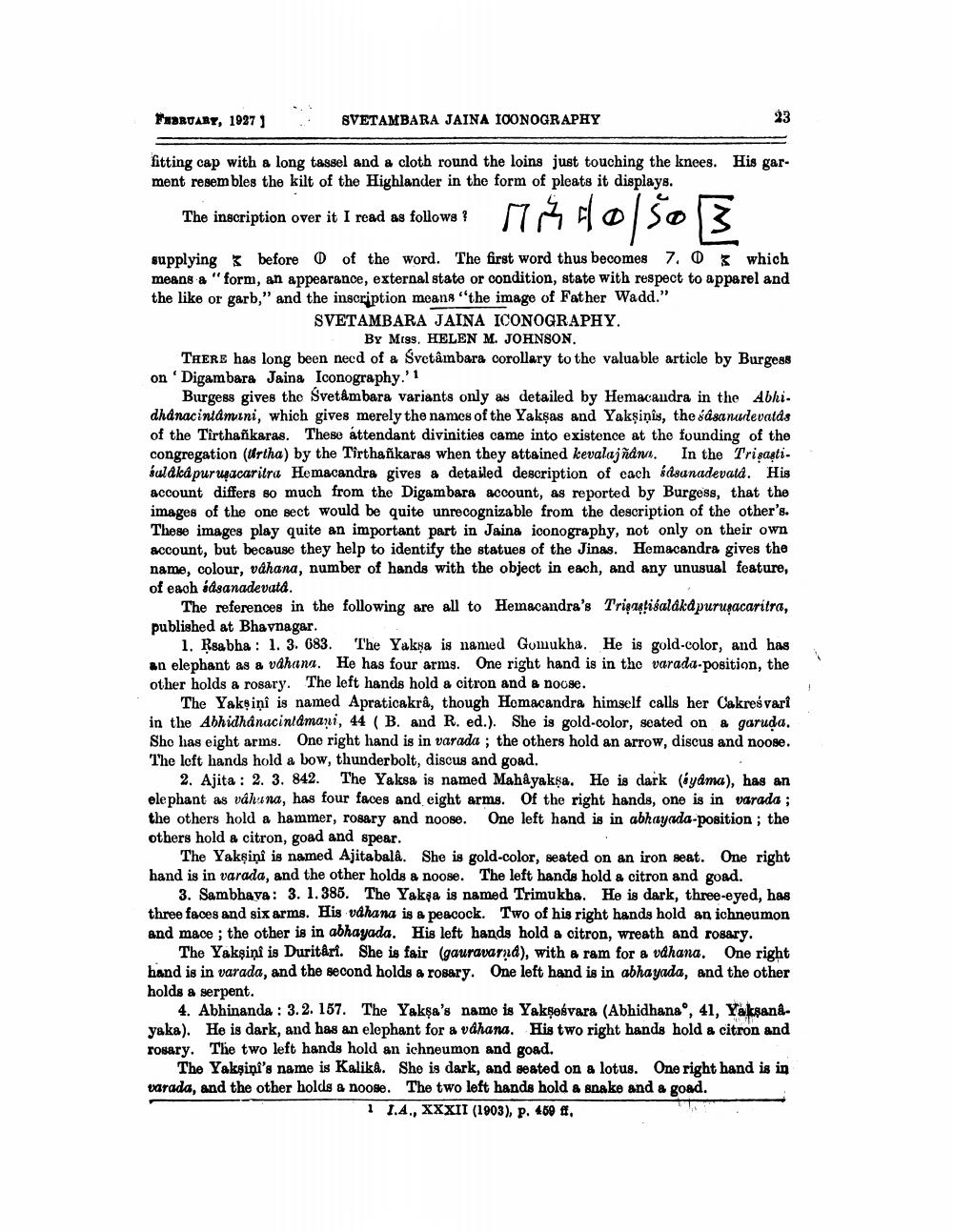________________
FEBRUARY, 1927]
fitting cap with a long tassel and a cloth round the loins just touching the knees. His garment resembles the kilt of the Highlander in the form of pleats it displays.
7340/503
The inscription over it I read as follows?
SVETAMBARA JAINA ICONOGRAPHY
23
supplying
which
before 0 of the word. The first word thus becomes 7. O means a "form, an appearance, external state or condition, state with respect to apparel and the like or garb," and the inscription means "the image of Father Wadd."
SVETAMBARA JAINA ICONOGRAPHY.
By Miss. HELEN M. JOHNSON.
THERE has long been need of a Svetâmbara corollary to the valuable article by Burgess on 'Digambara Jaina Iconography.'1
Burgess gives the Svetâmbara variants only as detailed by Hemacaudra in the Abhidhanacintamani, which gives merely the names of the Yakṣas and Yakṣinis, the sâsanadevatás of the Tirthankaras. These áttendant divinities came into existence at the founding of the congregation (urtha) by the Tirthankaras when they attained kevalajñana. In the Trisastisalaka purusacaritra Hemacandra gives a detailed description of each sdsanadevata. His account differs so much from the Digambara account, as reported by Burgess, that the images of the one sect would be quite unrecognizable from the description of the other's. These images play quite an important part in Jaina iconography, not only on their own account, but because they help to identify the statues of the Jinas. Hemacandra gives the name, colour, váhana, number of hands with the object in each, and any unusual feature, of each éasanadevatâ.
The references in the following are all to Hemacandra's Trisastiśalákápuruşacaritra, published at Bhavnagar.
1. Rsabha: 1. 3. 683. The Yakṣa is named Gomukha. He is gold-color, and has an elephant as a vahana. He has four arms. One right hand is in the varada-position, the other holds a rosary. The left hands hold a citron and a noose.
The Yakṣini is named Apraticakrâ, though Homacandra himself calls her Cakres vari in the Abhidhânacintamani, 44 ( B. and R. ed.). She is gold-color, seated on a garuda. She has eight arms. One right hand is in varada; the others hold an arrow, discus and noose. The left hands hold a bow, thunderbolt, discus and goad.
2. Ajita : 2. 3. 842. The Yaksa is named Mahayakṣa. He is dark (yama), has an elephant as váhuna, has four faces and eight arms. Of the right hands, one is in varada; the others hold a hammer, rosary and noose. One left hand is in abhayada-position; the others hold a citron, goad and spear.
The Yaksini is named Ajitabala. She is gold-color, seated on an iron seat. One right hand is in varada, and the other holds a noose. The left hands hold a citron and goad.
3. Sambhava: 3. 1.385. The Yakça is named Trimukha. He is dark, three-eyed, has three faces and six arms. His vahana is a peacock. Two of his right hands hold an ichneumon and mace; the other is in abhayada. His left hands hold a citron, wreath and rosary.
The Yakşini is Duritârî. She is fair (gauravarnd), with a ram for a váhana. One right hand is in varada, and the second holds a rosary. One left hand is in abhayada, and the other holds a serpent.
4. Abhinanda: 3.2. 157. The Yakṣa's name is Yaksesvara (Abhidhana, 41, Yakṣanâyaka). He is dark, and has an elephant for a váhana. His two right hands hold a citron and rosary. The two left hands hold an ichneumon and goad.
The Yakṣini's name is Kalika. She is dark, and seated on a lotus. One right hand is in varada, and the other holds a noose. The two left hands hold a snake and a goad. 1 I.A., XXXII (1903), p. 450 ff.




